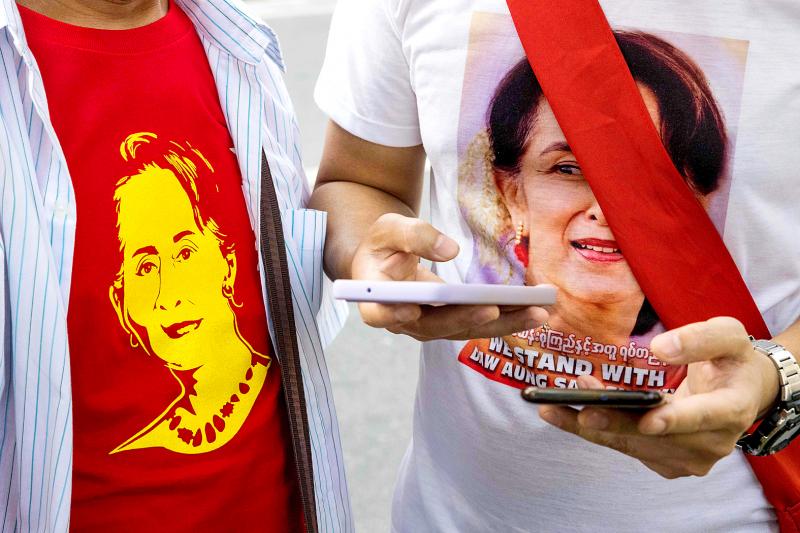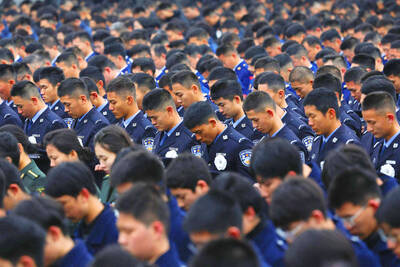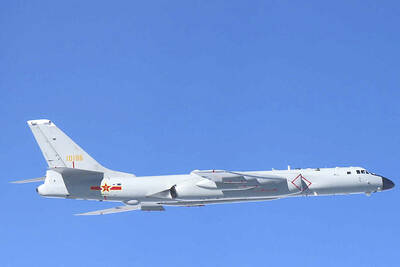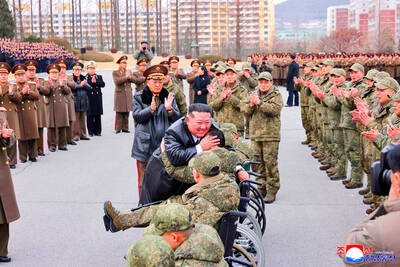The IMF last week sent US$350 million in cash to the Burmese government, part of a no-strings-attached emergency aid package to help it battle the COVID-19 pandemic.
Days later, Burmese military leaders seized power and detained Burmese State Counsellor Aung San Suu Kyi and other elected officials, in what the US Department of State on Tuesday said constituted a coup.
There appears to be little the IMF can do to claw back the funds, part of rapid-disbursing COVID-19 financing programs with almost no conditions and approved by the IMF board on Jan. 13, sources familiar with the payments and international finance experts said.

Photo: AFP
“We are following the unfolding developments closely. We are deeply concerned about the impact of events on the economy and on the people of Myanmar,” an IMF spokesperson said in a statement on Tuesday, confirming that the payment was completed last week.
US President Joe Biden, facing his first international crisis since taking office less than two weeks ago, has threatened new sanctions against the Burmese generals, and the state department said that it would review its foreign assistance to the Southeast Asian country.
The US is the dominant shareholder in the IMF, which has provided Myanmar with US$700 million in emergency COVID-19 financing over the past seven months, including last week’s payment, which included US$116.6 million through the IMF’s Rapid Credit Facility and US$233.4 million through the Rapid Financing Instrument.
The IMF on Jan. 13 said in a statement that the money would help Myanmar meet “urgent balance-of-payments needs arising from the COVID-19 pandemic, especially the government’s recovery measures to ensure macroeconomic and financial stability while supporting affected sectors and vulnerable groups.”
Unlike the IMF’s regular financing programs, which disburse funds in smaller increments as performance benchmarks are met for agreed policy reforms, COVID-19 emergency aid has been sent quickly, often all at once.
“It’s not a program that was negotiated, there isn’t conditionality and there aren’t forward-looking reviews with disbursements tied to those reviews,” said Stephanie Segal, a former IMF economist and US Treasury official who works with the Center for Strategic and International Studies in Washington.
“I’m not aware of any precedent where money that’s been approved by the IMF board can be recalled,” Segal added.
The IMF has since the beginning of the COVID-19 crisis provided emergency financing to 80 countries.
The timing of the latest payment to Myanmar was unfortunate, two sources familiar with the disbursement said, pointing to the risks of using rapid financing that gives governments broad discretion over how they spend the money.
The best-case scenario is that a Burmese administration that emerges from the current political turmoil would spend the money appropriately because it wants to have a productive relationship with the IMF, one of the sources said.
The sources expressed hope that the Central Bank of Myanmar can maintain its independence from the Burmese Ministry of Planning, Finance and Industry.
However, on Tuesday, the military appointed Than Nyein as the new central bank governor, reinstating him to a post he held from 2007 to 2013, during the rule of the last junta.
The World Bank, which has provided more than US$150 million in financing to Myanmar since the pandemic started, said on Monday that it was gravely concerned about the military takeover, warning that it risked a major setback to the country’s transition and its development prospects.

PARLIAMENT CHAOS: Police forcibly removed Brazilian Deputy Glauber Braga after he called the legislation part of a ‘coup offensive’ and occupied the speaker’s chair Brazil’s lower house of Congress early yesterday approved a bill that could slash former Brazilian president Jair Bolsonaro’s prison sentence for plotting a coup, after efforts by a lawmaker to disrupt the proceedings sparked chaos in parliament. Bolsonaro has been serving a 27-year term since last month after his conviction for a scheme to stop Brazilian President Luiz Inacio Lula da Silva from taking office after the 2022 election. Lawmakers had been discussing a bill that would significantly reduce sentences for several crimes, including attempting a coup d’etat — opening up the prospect that Bolsonaro, 70, could have his sentence cut to

China yesterday held a low-key memorial ceremony for the 1937 Nanjing Massacre, with Chinese President Xi Jinping (習近平) not attending, despite a diplomatic crisis between Beijing and Tokyo over Taiwan. Beijing has raged at Tokyo since Japanese Prime Minister Sanae Takaichi last month said that a hypothetical Chinese attack on Taiwan could trigger a military response from Japan. China and Japan have long sparred over their painful history. China consistently reminds its people of the 1937 Nanjing Massacre, in which it says Japanese troops killed 300,000 people in what was then its capital. A post-World War II Allied tribunal put the death toll

‘UNWAVERING ALLIANCE’: The US Department of State said that China’s actions during military drills with Russia were not conducive to regional peace and stability The US on Tuesday criticized China over alleged radar deployments against Japanese military aircraft during a training exercise last week, while Tokyo and Seoul yesterday scrambled jets after Chinese and Russian military aircraft conducted joint patrols near the two countries. The incidents came after Japanese Prime Minister Sanae Takaichi triggered a dispute with Beijing last month with her remarks on how Tokyo might react to a hypothetical Chinese attack on Taiwan. “China’s actions are not conducive to regional peace and stability,” a US Department of State spokesperson said late on Tuesday, referring to the radar incident. “The US-Japan alliance is stronger and more

FALLEN: The nine soldiers who were killed while carrying out combat and engineering tasks in Russia were given the title of Hero of the Democratic People’s Republic of Korea North Korean leader Kim Jong-un attended a welcoming ceremony for an army engineering unit that had returned home after carrying out duties in Russia, North Korean state media KCNA reported on Saturday. In a speech carried by KCNA, Kim praised officers and soldiers of the 528th Regiment of Engineers of the Korean People’s Army (KPA) for “heroic” conduct and “mass heroism” in fulfilling orders issued by the ruling Workers’ Party of Korea during a 120-day overseas deployment. Video footage released by North Korea showed uniformed soldiers disembarking from an aircraft, Kim hugging a soldier seated in a wheelchair, and soldiers and officials